
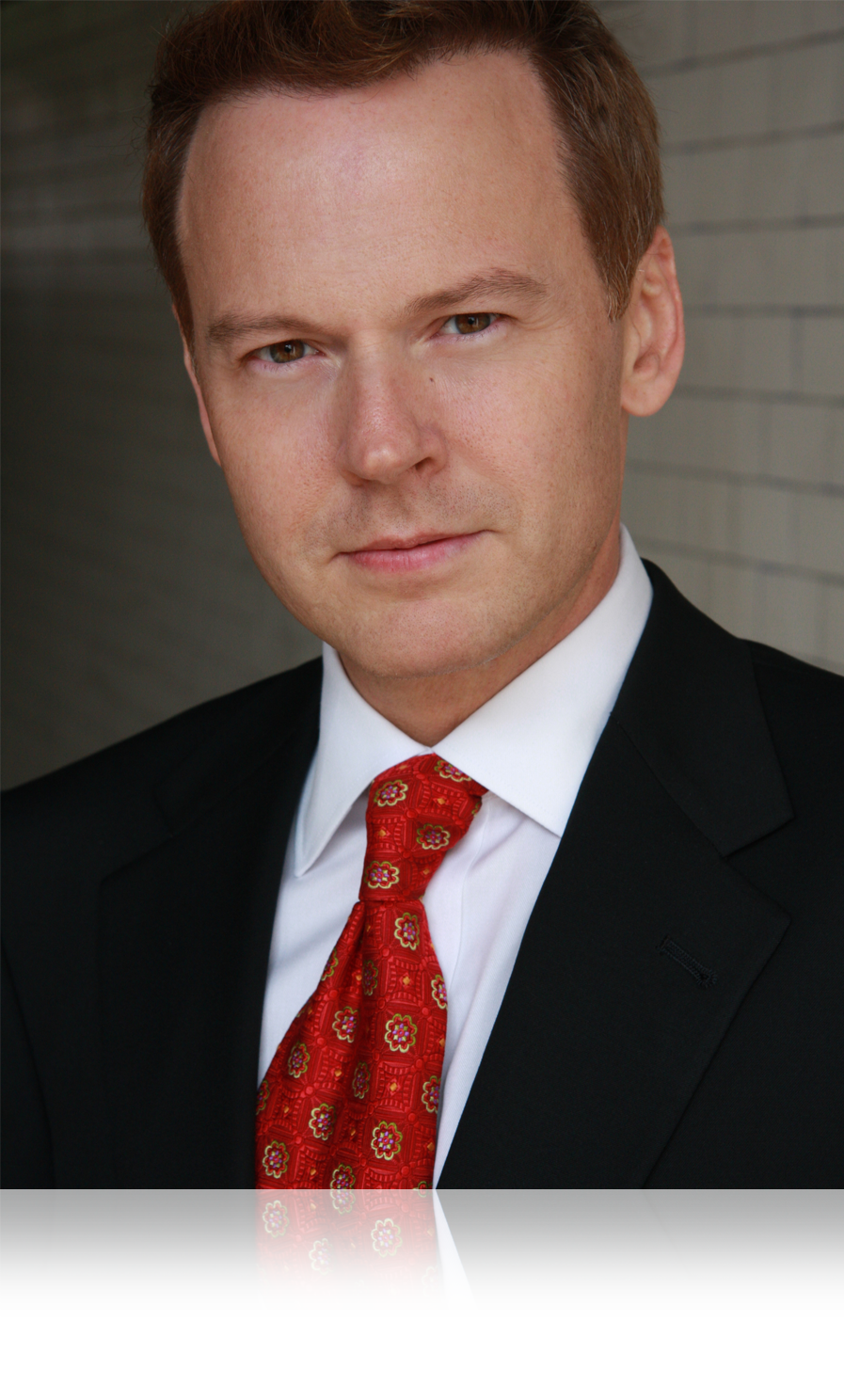
DR Andrew j. HAYDUKE
Liposuction is a cosmetic procedure designed to physically remove unwanted fat from your body using a small blunt metal tube and suction. The main purpose of liposuction is to flatten (sculpt down) bulging fat in one or more areas of your body. Liposuction is extremely popular. In fact, liposuction has replaced breast augmentation as the most frequently performed cosmetic surgical procedure in the United States according to one American Society for Aesthetic Plastic Surgery research study.
It is important to understand, however, that liposuction is not a method of weight loss. Liposuction is ideally used on bulging “problem” areas that have not responded well to diet and exercise in patients of normal (or near normal) weight. Occasionally, however, even overweight patients may benefit from sculpting of certain problematic bulging fat regions.
Both women and men have a tendency to store fat in certain predictable “fat depot” regions that are frequently resistant to both diet and exercise. These problem areas are often on the outer thighs, abdomen, love handles, hips and muffin top region on women and on the waist, abdomen and lower back on men. The face, neck, back, buttocks, inner thighs, under chin, and legs are also other treated areas.
Liposuction is the gold standard “time tested” proven method of sculpting down fat bulges by physically removing the problematic fat directly by suction. Many modern board certified plastic surgeons, including Dr. Hayduke, believe that the results of other alternative methods that market themselves as “non-surgical” or “non-invasive” fat reduction techniques are still simply not comparable with the time proven results seen with liposuction.
Liposuction evolution has lead to what some have called a more refined version of liposuction known as “liposculpture”. LIPOSCULPTURE uses extremely small, thin, blunt-tipped hollow tubes (cannulas), about the size of a small cocktail straw, which are inserted through tiny punctures in the skin. These ultra small cannulas are much smaller than the early generation thick liposuction cannulas. Fat is gently suctioned out through these small cannulas. Dr. Hayduke first carefully marks out the problem areas directly on the patients skin and confirms these markings with the patient. Dr Hayduke then carefully directs these cannulas under the patient’s skin to target the specific unwanted fat deposits. The fat bulges are artistically sculpted down in a meticulous controlled fashion. The fat cells are physically removed and collected in a container which is later discarded. With liposculpture, no ultrasound or laser or other destructive methods to liquefy the fat first are required. This, of course, avoids the additional complications associated with adding lasers, ultrasound, and other methods to liposuction.
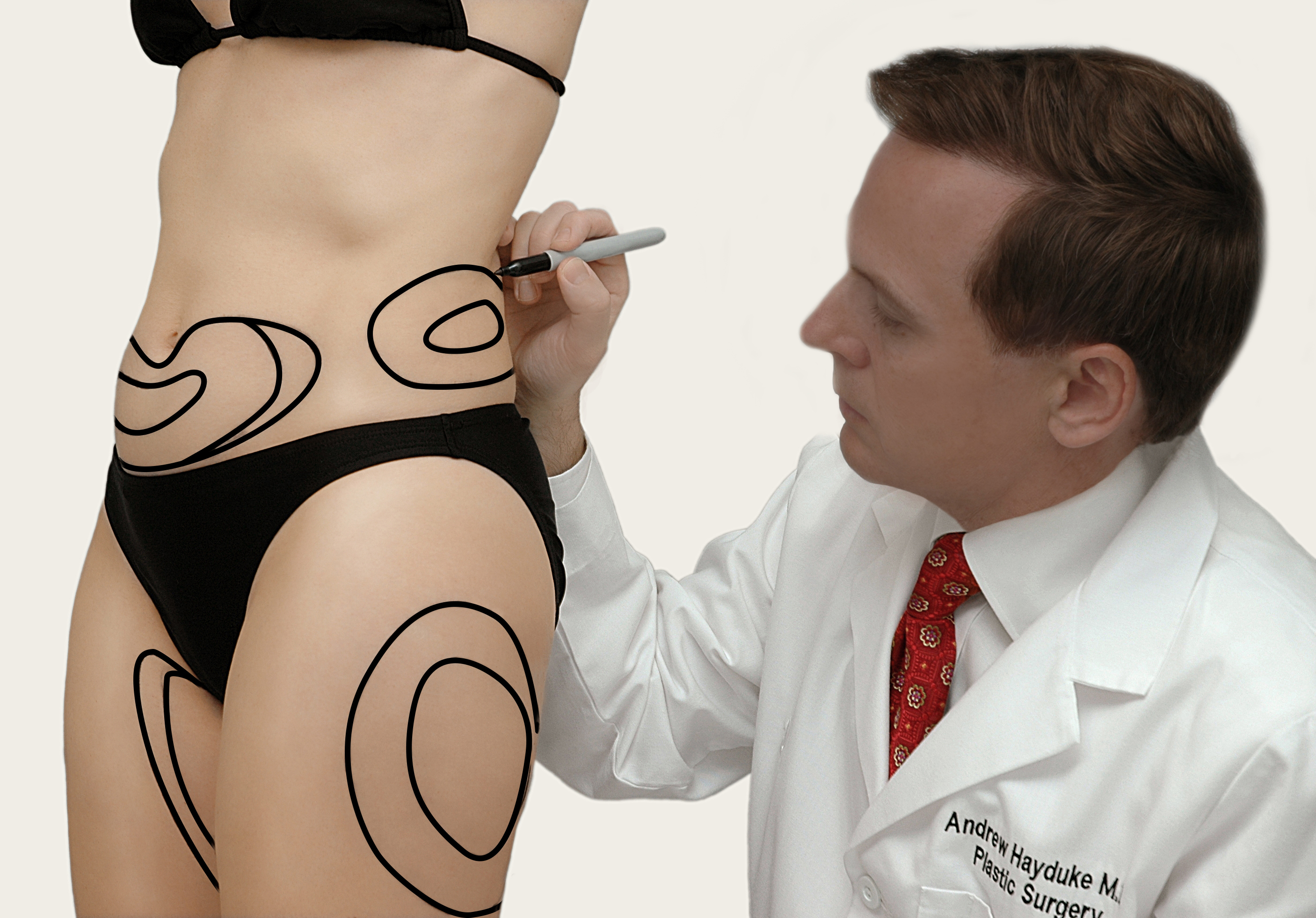
Various liposuction techniques and variations have evolved over the years. Usually these variations of liposuction add something before the fat suction is actually performed, such as a laser treatment of the fat or an ultrasound treatment of the fat first. Their is no true consensus among board certified plastic surgeons that adding any of these additional treatments (ultrasound, laser, etc) to liposuction (liposculpture) is actually superior in terms of the final result compared to just pure liposuction (liposculpture).
TUMESCENT LIPOSUCTION: Tumescent liposuction refers to a technique that uses a very dilute local anesthesia liquid that is injected into the body fat causing the targeted areas to become “tumescent” (swollen and firm). Local anesthesia is widely regarded as the safest form of anesthesia. A local anesthetic is used to first gently numb the area of your body where the cannula (small tube) will be inserted. Next, more dilute anesthetic tumescent solution (liquid) containing lidocaine and epinephrine is injected into the fatty tissue before liposuction is actually performed. Tumescent liposuction does not require general anesthesia. The advent of tumescent liposuction permits liposuction to be done totally by local anesthesia with almost no blood loss. It can be done in the office setting with patients totally awake.
LIPOSCULPTURE: Tumescent fluid, just as in tumescent liposuction, is used in this approach. This procedure (some call liposculpture) is still in essence tumescent liposuction. Dr Hayduke feels the use of very small cannulas (some call micro-liposculpture cannulas) to suction out the fat during liposculpture, however, may help achieve less patient discomfort and allows for excellent sculpting precision because of the finer nature of the cannulas used during liposculpture. Liposculpture is performed in the office setting under simple local anesthesia. Patients are awake and even able to carry on a conversation with the doctor during the actual procedure.. It takes more time for the surgeon to perform the sculpting with these small finer cannulas, however, it allows for a more meticulous sculpting of the unwanted fat bulges. Dr. Hayduke feels their is simply more control of the actual sculpting with this technique and less chances of contour problems since the cannulas used are very small. Dr. Hayduke performs this procedure (liposculpture) in the office without the need for either general anesthesia or even intravenous sedation. Patients are comfortable and awake the entire time. Dr. Hayduke’s background in sculpture and art are a perfect compliment for this approach to liposuction. Liposculpture is Dr. Hayduke’s favorite form of modern liposuction. Liposculpture can be considered a more refined version of modern day tumescent liposuction.
ULTARASOUND-ASSISTED LIPOSUCTION:These techniques use ultrasound to liquefy the fat before fat suction. Seromas (pockets of stubborn persistent fluid accumulation) are more common complications after ultrasonic assisted liposuction because some believe that ultrasonic cannulas create heat that injures blood vessels and lymphatic vessels. When lymphatic vessels are heated and damaged, fluid may collect within the empty cavities where fat was removed. These cavities can become fluid filled problematic seromas. Seroma formation is considered a complication of this procedure.
Vaser Lipo
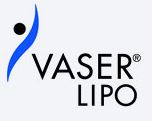
This device that uses ultrasound waves to shake loose fat cells, which are then removed using a suction cannula.
LASER-ASSISTED LIPOSUCTION
These techniques use lasers to liquefy the fat first, which is then usually suctioned out at the end of the procedure using a cannula (usually). From a marketing standpoint, patients love to hear the word “laser” since it imparts a certain sense of modern cutting-edge technology. The reality is, however, it is still basically liposuction. The difference is, however, a laser is used to liquefy the fat first. Most board certified plastic surgeons would likely agree that this method is not superior to tumescent liposuction (liposculpture) techniques despite the manufacturer created hype of a “laser” being involved. Heat burns from the laser itself as well as seromas (from left over laser liquefied tissues) and skin pigment (color) changes are some of the complications that can occur. In addition, some practitioners may even take shortcuts and just apply the laser to the fat but not actually suction out the liquefied fat.
SMART LIPO
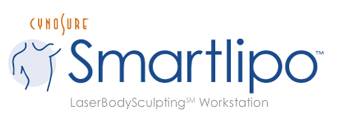
Smart Lipo (also referred to as laser liposuction) uses laser energy to liquefy fat before it’s removed from the body with a small tube called a cannula. In some cases, however, the doctor may not actually suction out the fat at the end, but leave the fat alone hoping that the fat would somehow be absorbed by the body after liquefying it with the laser. Clients may not even be aware if the doctor is skipping the step of suctioning out the liquefied fat. Dr. Hayduke feels that if the fat is not actually suctioned out by the practitioner when using this machine, then this procedure should not be classified as “laser-assisted liposuction” since no true liposuction was actually involved. Proper use of this technique usually requires suction of the fat at the end of this procedure. Any tangible benefit over standard liposuction (liposculpture) is still questionable. Adding a laser treatment before liposuction, however, adds the risk of additional complications that are specific to the laser itself.
LIPOTHERME

Lipotherme is a competitor to SmartLipo. It is a procedure that uses a hot laser to liquefy fat in targeted body zones. In addition to liquefying fat, Lipotherme claims a thermal effect that the manufacturer claims may possibly cause the skin to contract somewhat. The doctor inserts a hollow tube into the skin. A hot laser beam (at 980 nm) is directed at the fat cells underneath, and it heats up the fat cells, eventually rupturing them. It is possible to get a burn from this laser since heat is involved. The fat cells get liquefied and then they are supposed to be suctioned out of the body via the cannula. Patient tend to like the gimmicky lights and gimmicky video screen present in this particular machine. Regardless of manufacturer claims, the benefits of this laser assisted technique over standard liposuction (liposculpture) are still very questionable.
COOL LIPO

Cool Lipo is also a laser assisted liposuction approach that uses a wavelength of 1320 nm that the manufacturer claims is absorbed by water, fat, and collegen. This is in contrast with SmartLipo wavelength which some say may be absorbed by tissue pigments and has the potential to cause color changes in the skin. That is how some owners of the Cool Lipo machine market their machine. We are not sure, however, of the validity of these claims. Because of the closeness of the names, this method is frequently confused with “Coolsculpting”. CoolLipo is totally different than Coolsculpting.
Please take the time to visit this interesting link forThe Wall Street Journal health blog article about laser use with liposuction and the lack of an advantage of adding laser to pure liposuction.
In general, liposuction (and its variations) are usually done as an in-office procedure with the patient totally awake in a properly equipped plastic surgeon’s office. In general, it does not require an overnight hospital stay unless an extremely large volume of fat is being removed. Local anesthesia is used in most cases. If an exceptionally large volume of fat is being treated in one massive session, general anesthesia or deep sedation may rarely be used. Dr. Hayduke, however, generally prefers to do these exceptionally large cases as staged procedures, separating the procedure into two stages – each done in the office setting without the need for general anesthesia. Dr. Hayduke feels that is a safer approach.
If a patient is having another cosmetic procedure under general anesthesia, such as a breast augmentation, tummy tuck or facelift surgery, then liposuction can be easily done at the same time while in the operating room. As is always the case with any cosmetic surgical procedures, it is advised that patients only choose a true board certified plastic surgeon who has active hospital privileges to perform liposuction (as well as hospital privileges to admit patients overnight). This holds true even if your cosmetic procedure is small and being done in the office setting on only one minor bulging fat area. When it comes to cosmetic surgery and your health, it is not a good idea to simply choose the lowest priced bidder or the most aggressive advertiser for any given procedure.
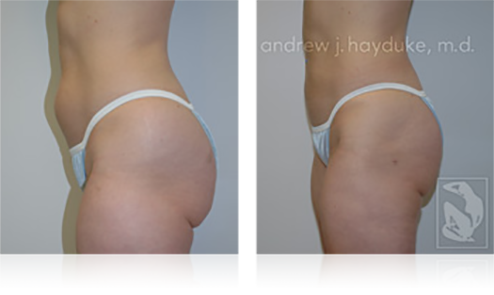
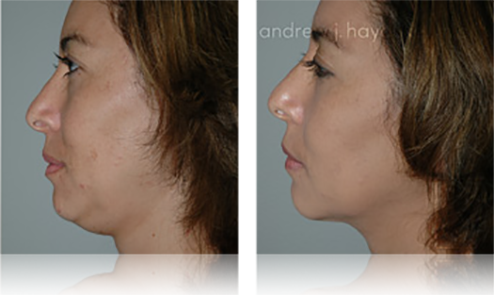
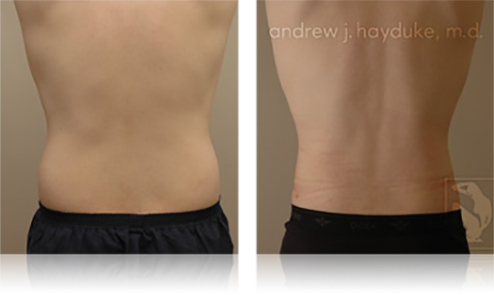
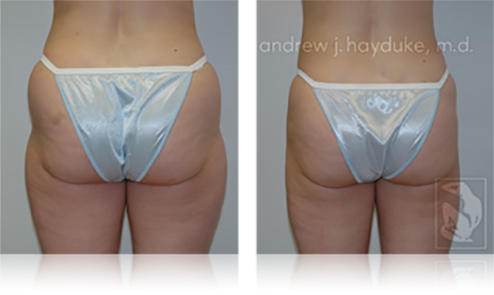
Visit Dr Hayduke’s portfolio page to see more before and after photos.
Frequently and aggressively marketed as “non-invasive” or “non-surgical” approaches to fat reduction, these methods are most commonly performed by non plastic surgeons (such as gynecologists, family physicians, general practitioners, retired emergency room doctors, etc) who likely took a short instructional course sponsored by the manufacturer of the machine. Many times these physicians are trying to simply increase cash flow to their practice by adding some type of “fat reduction treatment” to their services even though cosmetic procedures are totally unrelated to the actual field (specialty) they were formally trained in.
These non-liposuction fat reduction methods usually lure in patients with a relatively low up front cost (for the first treatment) and claims of “non-invasiveness” and “safety”. Frequently there are also claims of “no down time” which is very appealing to the consumer. What potential clients frequently fail to understand, however, is that the effectiveness of the actual procedure is usually highly questionable. Even if it is relatively cheap, is it really a good deal if the effectiveness of the treatment is minimal or extremely poor? As far as the aggressive marketing claims made by the manufactures (and by the physicians who are trying to advertise their newly purchased machines), astute consumers might be correct to sometimes think “If it sounds too good to be true, it’s probably not true.”
Consumers should definitely not consider an “FDA” stamp on any of these devices as a guarantee of device effectiveness. The FDA is an agency that basically conducts a risk-benefit analysis that allows an item to be marketed for particular indications – sometimes requiring little or no testing. The vast majority of devices that undergo FDA review are moderate-risk Class 2 devices such as medication pumps, some surgical lasers and fat reduction devices. Many are granted FDA clearance through a controversial process called 510(k). (Low-risk Class 1 devices, like stethoscopes and gauze, are exempt from review.) Products get FDA 510(k) clearance if they’re found to be “substantially equivalent” to a legally marketed device, meaning they have the same intended use and technological characteristics — or, if not, that the differences don’t raise serious concern. There’s no requirement of actual clinical testing to determine the safety and effectiveness of 510(k) submissions, though the FDA does ask for clinical data in only about 10 percent of cases (according to a Chicago Tribune article). Unfortunately, consumers immediately assume that an “FDA” stamp on a device means that the device is very effective and works extremely well. Obviously, this is simply not true. Consumers should not fall for this marketing tactic.
Some consumer advocates also worry that insufficient FDA testing in the FDA 510(k) system lets unsafe or ineffective products slip through. As the chain of “substantially equivalent” devices grows, the less likely it is the new ones bear any resemblance to the original, and usually there’s been no evaluation of safety or effectiveness in between, said Dr. Michael Carome, deputy director of the Health Research Group at Public Citizen, a nonprofit consumer rights group. Devices later found faulty or even recalled aren’t automatically removed from the list, Carome said, so new products could be cleared based on tainted precedents.
Another marketing tactic is to present data from a “research study” that claims effectiveness. Physicians were formally trained in medical school on how to analyze a “research study” and how to determine if the results from a research study are truly meaningful. The general public, however, is not trained on how to actually analyze a scientific research study. One important consideration when reviewing any “research study” is to look at who actually funded the research study in the first place. Their is a huge conflict of interest if the study was funded (and the researchers were directly paid) by the same company that basically showed effectiveness of their machine in the study. In addition, was the study actually published in a peer reviewed respected medical journal, such as the famous plastic surgery journal known as Plastic and Reconstructive Surgery? If a study makes it to actual publication in this level of a medical journal, be assured that the study was actually reviewed by a committee of professional reviewers before it was allowed to be published. Many studies are rejected after review by this committee if the methods used in the study were poor or questionable. There are, however, many less respectable journals, magazines and even websites that would easily allow publication of any research study that may have been rejected elsewhere.
One common thread to these non-liposuction approaches seems to be that the unwanted fat itself is not actually suctioned out of the patient. Surprisingly, the fat is not physically removed at any time during the treatment. Most of these approaches are marketed as somehow causing the fat to be magically “absorbed” or “eliminated” by the body without the need to actually physically remove the fat. These approaches generally cost less than liposuction (liposculpture) per individual treatment (for the first treatment) – however – multiple repeat treatments on the same exact area (with additional fees for each treatment) are frequently required with some of these approaches, and hence ultimately the final cost per problematic area may sometimes be just as much as real liposuction (liposclupture) for that same area. Although some modest results may occasionally be seen (varies by machine/technique used), most board certified plastic surgeons would likely agree that the final results are simply not equivalent to those seen with true liposuction (liposculpture) performed by a formally trained plastic surgeon. The core reason is possibly because the unwanted fat is not actually physically removed from the patient, but rather left to somehow be reabsorbed (claims are frequently made that the fat subsequently disappears over time on its own).
COOLSCULPTING

According to the manufacturer, this technique claims to work by cooling down fat cells and then allowing fat to somehow be eliminated without actually being physically suctioned out of the patient. CoolSculpting supposedly delivers controlled cooling to target the fat cells underneath the skin. The treated fat cells are said to then become crystallized (frozen), then die. Over time (months), your body supposedly eliminates these dead fat cells on its own. Multiple repeat procedures are involved. The manufacturer aggressively advertises Coolsculpting as being “FDA cleared”, which in reality is not a absolute guarantee of actual effectiveness of this technique. Physicians marketing this device sometimes falsely use the incorrect term “FDA approved” in their advertisements for Coolsculpting, instead of the proper words “FDA cleared”. Most board certified plastic surgeons would likely agree that the results of this non liposuction approach are inferior to liposuction (liposculpture).
ZELTIQ
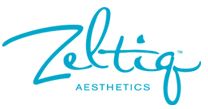
Also claims to use cooling to destroy fat cells. This is a competitor to Coolsculpting.
ULTRASHAPE

The UltraShape System is marketed as a body shaping device that uses pulsed, focused ultrasound to mechanically (non-thermally) and selectively destroy fat cells at a designated focal point in the subcutaneous fat tissue without effecting the skin, blood vessels, nerves or connective tissue. Complete treatment protocol requires a few months – 3 treatments at two-week intervals. The unwanted fat is not actually suctioned out of the patient. Most board certified plastic surgeons would likely agree that the results of this non liposuction approach are inferior to liposuction (liposculpture).
VELASHAPE

Vacuum and specially designed rollers for mechanical massage of the skin facilitate heat energy delivery. The net result supposedly increases the metabolism of stored energy, increases lymphatic drainage and claims to reduce or shrink the size of the actual fat cells and fat chambers. The company claims that by a combination of bi-polar radiofrequency (RF) and infrared (IR) technology, in conjunction with vacuum-and mechanically-powered tissue manipulation, the VelaShape somehow raises the temperature of fatty tissue Most board certified plastic surgeons would likely agree that the results of this non liposuction approach are inferior to liposuction (liposculpture).
ZERONA

Zerona is a low-level laser device developed by Erchonia Corp. for non-invasive body slimming of the waist, hips, and thighs. It claims to disrupt the fat cell membranes causing the release of stored lipids and fatty material, in turn, promoting fat cell collapse. The device was first introduced to the market in 2008 as an off-label use device for slimming. Zerona laser treatments are generally a series of 6 treatments over a 2 week period by a laser overlying the body areas you want reduced. Most board certified plastic surgeons would likely agree that the results of this non liposuction approach are inferior to liposuction (liposculpture).
LIPOSONIX

Ultrasound energy is focused on targeted fat. The fat is not physically suctioned out at all. Liposonix claims that the treated fat tissue is removed supposedly through “the body’s natural healing and elimination process.” Most board certified plastic surgeons would likely agree that the results of this non liposuction approach are inferior to liposuction (liposculpture).
VANQUISH

Another gimmicky procedure that claims to deliver radio frequency energy into fat tissue by focusing radio frequency energy into fat layers, while restricting the delivery of high heat elsewhere. No suction of fat is involved. The fat supposedly goes away on its own. Most board certified plastic surgeons would likely agree that the results of this non liposuction approach are inferior to liposuction (liposculpture).
LIPO DISSOLVE

Lipodissolve treatment involves a drug mixture directly injected into the body. These shots are meant to somehow dissolve or melt away body fat without surgery. Also known as injection lipolysis, Flab Jab, Lipozap, Lipotherapy, and Mesotherapy. Lipodissolve requires shots over a number of sessions
The Lipodissolve procedure is not approved by the FDA. In fact, The FDA has warned consumers about the safety and marketing claims associated with some of these injection techniques. As with other “non-surgical” approaches to fat reduction, no actual suction of fat from the body is performed.
Please take the time to read this warning letter regarding this injection based fat reduction method from the FDA.
Since liposuction (liposculpture) and other fat reduction techniques are not covered by health insurance, many physicians from different specialties will try to capture you as a liposuction (or fat reduction procedure) client. It is likely that liposuction is the number one procedure that has more “non-plastic surgeons” trying to perform it compared to any other cosmetic procedure in the USA. For this reason, consumers should be very meticulous when researching liposuction (fat reduction) procedure physicians. If you research and actually dig into the credentials of the physician advertising for your liposuction or fat reduction procedure, you may be amazed at what you will find. We feel that the first and most important recommendation is selecting a formally trained PLASTIC SURGEON who is board certified by the American Board of Plastic Surgery (ABPS).
If you find a true board certified plastic surgeon (ABPS certified) or other physician who seems to offer many techniques marketed as “non-surgical” or “minimally invasive” approaches to fat reduction, you may be smart to wonder if they are doing so just to simply get more clients in the door. Perhaps they market these “flavor of the month” procedures regardless of the actual effectiveness of these “non-surgical” procedures. Some may use the tactic of saying they offer “all” the fat reduction procedures available or “more choices” than any other physician in the geographic area. We believe that should be a cautionary red flag to consumers as well. Just because a certain fat reduction method is currently aggressively marketed (seen on many magazine ads, billboards, television commercials, TV talk shows, internet searches, etc) does not mean that it is the most effective or modern technique available. In reality, it may actually not be very effective at all. In fact, if you wait about 18 months, you will probably see a new slick advertising campaign for a new method of fat reduction (usually with a new catchy name) take over as the dominant advertised technique. All of a sudden, the once massively advertised technique that you once thought was the ultimate answer to fat reduction will no longer be seen or heard about at all in any advertisements or media source. It likely lost its popularity because its effectiveness (in the real world) proved to be very poor. The cycle continues and consumers should be aware of this mass media marketing cycle for gimmicky fat reduction procedures.
Another point to consider is that if you are not seeing a true plastic surgeon for your fat reduction issues, then you may simply be offered a given procedure (treatment) whether or not you are actually a good candidate for it. For example, a female with multiple children (stretched abdomen) and loose hanging abdominal skin is likely a great candidate for a tummy tuck (abdominolpalsty) rather than liposuction or any other gimmicky fat reduction procedure. If that particular client goes to a physician who cannot perform a tummy tuck (since that physician is actually not a plastic surgeon), unfortunately, they will likely be offered whatever machines or techniques the physician has available to them in their office. This is unfortunately a common way that clients lose (waste) thousands of dollars with little or no improvement whatsoever in their original problem area.
Although it is hard to believe, in the state of California, your surgeon does not need to be a formally trained plastic surgeon or board certified by the ABPS in order to perform liposuction or fat reduction procedures. Board certification is simply not mandated. Any licensed medical doctor (M.D.) or Doctor of Osteopathy (D.O.) from any specialty can legally perform liposuction or fat reduction procedures as long as the patient signs the consent form for the procedure. The physician may actually be a gynecologist, family doctor, retired emergency room physician, general practitioner, radiologist etc. It is left up to the patient to actually double check if their surgeon is actually board certified by the ABPS by visiting www.abplsurg.org and clicking/tapping on the “is your surgeon certified” tab. It is very easy to be confused by other official sounding boards and certifications posted on ads and websites.
To find out if your potential surgeon holds any board certification (formally recognized by the American Board of Medical Specialties) in any specialty whatsoever, we suggest you visit www.certificationmatters.org and discover which SPECIFIC board certification (if any) your potential surgeon actually holds. We highly suggest that you choose a surgeon board certified by The American Board of Plastic Surgery if you are thinking of having PLASTIC SURGERY on your body – it only makes sense. Visiting www.certificationmatters.org is also a way to find out which specific specialty your potential surgeon was truly trained in – rather than relying upon slick ads with confusing phrases that may indirectly (and falsely) suggest certification in plastic surgery.
Once you are assured that your potential plastic surgeon meets this very important standard of formal training in plastic surgery, then you can determine if they are truly the right physician based on your own personal consultation with the doctor and a careful review of the doctor’s past results. Take your time, do your own research (do not rely solely upon flashy advertising or upon your friend’s research) and make your choice wisely. If patients are diligently researching a procedure to help improve their unsightly bulges of problematic fat, it would be wise to also spend a equal amount of time researching the actual physician’s credentials offering the procedure. When researching liposuction (liposculpture), physician credentials, and other alternative fat reduction techniques – it is truly a jungle out there. Take your time and choose wisely.
All logos and company names used in this article are trademarks of their respective companies.